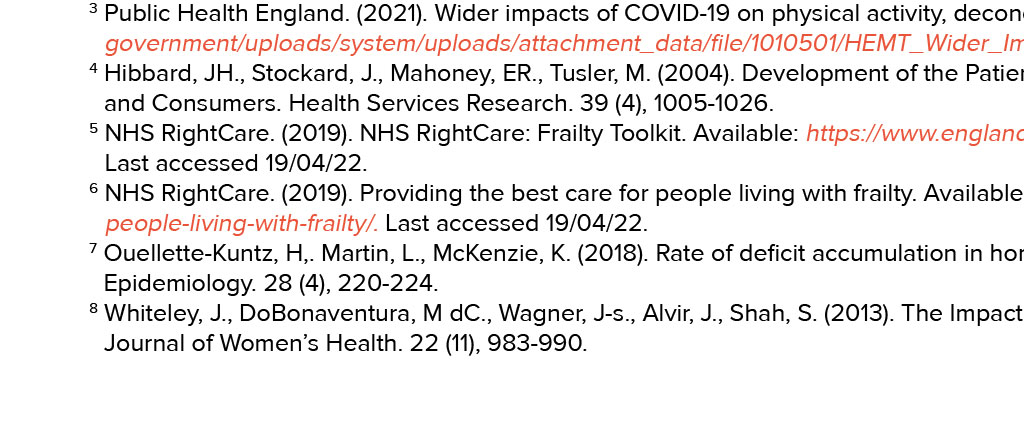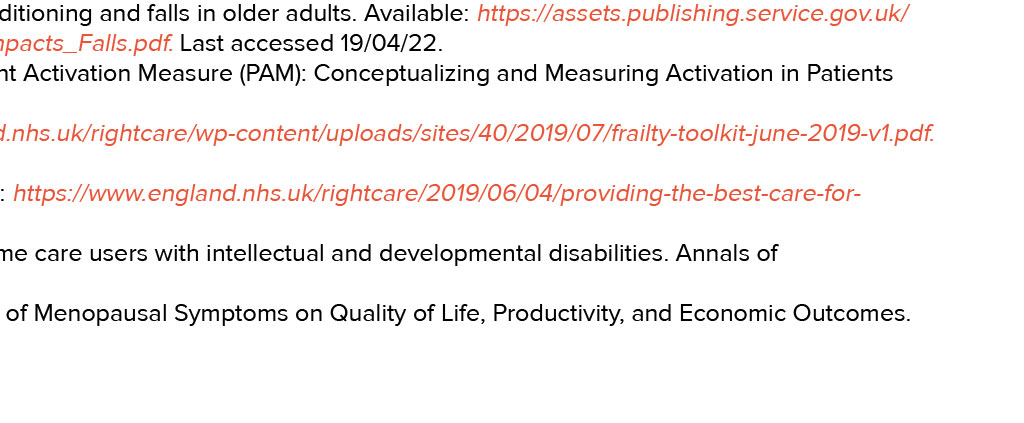




























THE CENTRE FOR AGEING BETTER Healthy ageing Helping our populations stay healthy for longer L Helen Oliver, Business Development Director and Deputy Chief Executive Officer at Eastern AHSN, outlines how we are supporting innovations and networks that are helping people take a greater role in their own health and staying healthier for longer ike many, I moved a lot less during lockdown. A lack of commute, places being closed, home schooling and a ban on socialising meant more time sat at home. Im not alone, with Sport England reporting that the pandemic led to unprecedented decreases in activity levels across all age groups1, but particularly among individuals with more long-term health conditions and older people2. This is likely to have led to the loss of physical, psychological, and functional capacity due to inactivity in these groups. This has a number of health impacts, including increasing the risk of falls3. As time passes, we will have a better understanding of the longer-term impacts this will have on peoples health and quality of life. But we know that helping people live longer and healthier lives was a priority in the NHS Long Term Plan even before the pandemic and will be vital in enabling the healthcare system to recover from COVID-19. At Eastern AHSN, we have supported several programmes this year aimed at improving peoples wellbeing and supporting healthy ageing. Norwich Institute of Healthy Ageing Eastern AHSN is a partner in the Norwich Institute of Healthy Ageing (NIHA), which develops and implements effective strategies to promote sustained population behaviour change, to improve physical and mental wellbeing. The NIHA is inter-disciplinary in its approach, examining human behaviours in an integrated way and delivering large-scale cohort and (pragmatic) intervention studies. I sit on its steering group and co-chair the NIHA Behaviour Inequalities in Health Group, helping them identify and build key partnerships and scope potential funding opportunities. While it is still early days for the NIHA, we hope to continue supporting the organisation as it makes breakthroughs that can be translated into patient impact. Prof. Anne-Marie Minihane, Director of Norfolk Institute of Healthy Ageing (NIHA): Promoting the sustained population behaviour change required to improve physical and mental wellbeing requires collaboration across the whole health and care system. Eastern AHSN has been committed to finding solutions that work and convening the right partners to make it happen Active+ME REMOTE I am a lot more aware of my health issues I became a lot more involved in trying to change that for the better, rather than for the worse Female Active+me REMOTE pilot participant, 47 years old Eastern AHSN worked with Cambridge University Hospitals NHS Foundation Trust to pilot delivery of its cardiac rehab programme digitally, using Active+me REMOTE by Huntingdon-based company Aseptika. Active+me REMOTE combines exercise classes with monitors to record patients health metrics at home that are uploaded to an app and shared with their personal health coach. It aims to enable patients to exercise safely, monitor their own health and improve how they feel about being able to cope living with a heart condition. The pilot was evaluated by Sheffield Hallam Universitys Advanced Wellbeing Research Centre (AWRC), using funding from Innovate UK and with support from Yorkshire and Humber AHSN. The primary aim of the evaluation was to determine whether participating in cardiac rehabilitation with Active+me REMOTE led to an increase in patient activation measure (PAM) score a validated, licensed tool that measures peoples knowledge, skills and confidence in managing their own health and healthcare (referred to as patient activation), scored between 0 and 100. The findings have been published in the BMC Health Services journal and concluded that participation in standard cardiac rehabilitation with Active+me is associated with increased patient activation. The data showed that the average PAM score increased from 65.5 (level 3 taking action) to 70.2 (level 4 maintaining behaviours and pushing further), indicating a potential reduction in the risk of future admission to hospital and use of healthcare services. We are now in discussion with other providers across different AHSNs about how this innovation could support their outpatient services. Read more on our website. Understanding patient activation Up to a third of women will experience severe menopausal symptoms that can impact on their quality of life. However, a 2016 survey found that 50% of women aged 45-65 who had experienced the menopause in the past 10 years had not consulted a healthcare professional Patient activation is a measure of a persons knowledge, skills and confidence to manage their own health and wellbeing and is a core enabler for supporting selfmanagement and personalising care. The Patient Activation Measure (PAM) is a tool used to quantify patient activation4. Eastern AHSN sometimes works with innovations to use this metric to compare patient activation before, during and after an intervention. Helping identify frailty risks earlier in people with learning difficulties Signs of ageing often appear earlier in people with learning disabilities, including autism5, 6. This is due to a variety of reasons, including chromosomal differences, side effects from polypharmacy over significant periods and prevalence of other long-term health conditions7. The NHS Long Term Plan made a commitment to continue the Learning Disabilities Mortality Review (LeDeR) and to improve the health and wellbeing of people with a learning disability. Locally, Eastern AHSN is supporting a pilot with Hertfordshire County Council and Hertfordshire Community NHS Trust with support from the University of Hertfordshire to validate Frail+LD, a tool that has been developed locally in line with LeDeR and NICE recommendations for an individualised assessment of frailty and consideration of comorbidities and underlying health conditions in people with learning disabilities. Frail+LD is a clinical support tool for health care professionals to support the identification of frailty risks sooner in people with learning disabilities through clinical assessment. The outcome for Frail+LD is to manage and help people with a learning disability to live well for longer and reduce deaths from frailty-related conditions. Eastern AHSN is supporting the Frail+LD project by providing funding for the validation and has brokered the pilot, which went live in March and is due to run until December 2022. Charco CUE1 is a wearable device developed by Charcos team of engineers, doctors and neuroscientists for Parkinsons patients. It works by providing focused vibrotactile stimulation to reduce the symptoms of slowness and stiffness that people with Parkinsons experience. Pilot tests demonstrate a 16% improvement in everyday movement. We have been supporting Charco to develop CUE1s value proposition, secure funding for further development and introduce them to potential partners for pilots. Find out more in our Charco innovator spotlight. Lumino Up to a third of women will experience severe menopausal symptoms that can impact on their quality of life. However, a 2016 survey found that 50% of women aged 45-65 who had experienced the menopause in the past 10 years had not consulted a healthcare professional about their menopause symptoms. We are working with innovation company Lumino to pilot a therapeutic app-based tool called Seren in the East of England, which supports women experiencing the menopause. The evidence-based clinical resources contained within Seren are built on a detailed understanding of the psychological impact of the menopause and it has been co-produced with digital experts and women who have and are experiencing the menopause. Lumino are on Cambridge Judge Business Schools Accelerate Cambridge incubator programme, having completed the Cambridge Social Ventures incubator programme last year. As well as providing mentoring to the team, we are hoping to secure a pilot of Seren with primary care partners in the coming year. Share this article Return to the contents page Learn more: If you want to learn more about how we are helping people take a greater role in their own health and staying healthier for longer, contact Helen Oliver, Business Development Director and Deputy Chief Executive Officer at Eastern AHSN, at helen.oliver@eahsn.org. Up next: Lucy Jung, co-founder at Charco Neurotech, explains how Eastern AHSN has helped them scale their business, better understand their market and secure funding for development. References Sport England. (2021). Active Lives Adult Survey November 2019/20 Report. Available: https://sportengland-production-files.s3.eu-west-2.amazonaws.com/s3fspublic/2021-04/Active%20Lives%20Adult%20November%202019-20%20Report.pdf?VersionId=OjWdwCLnI3dNgDwp3X4ukcODJIDVG7Kd. Last accessed 19/04/22. 2 Giles, A. (2021). Staying indoors: The long-term impact of lockdown on older adults health. Available: https://ageing-better.org.uk/blogs/staying-indoors-the-long-termimpact-of-lockdown-on-older-adults-health. Last accessed 19/04/22. 3 Public Health England. (2021). Wider impacts of COVID-19 on physical activity, deconditioning and falls in older adults. Available: https://assets.publishing.service.gov.uk/ government/uploads/system/uploads/attachment_data/file/1010501/HEMT_Wider_Impacts_Falls.pdf. Last accessed 19/04/22. 4 Hibbard, JH., Stockard, J., Mahoney, ER., Tusler, M. (2004). Development of the Patient Activation Measure (PAM): Conceptualizing and Measuring Activation in Patients and Consumers. Health Services Research. 39 (4), 1005-1026. 5 NHS RightCare. (2019). NHS RightCare: Frailty Toolkit. Available: https://www.england.nhs.uk/rightcare/wp-content/uploads/sites/40/2019/07/frailty-toolkit-june-2019-v1.pdf. Last accessed 19/04/22. 6 NHS RightCare. (2019). Providing the best care for people living with frailty. Available: https://www.england.nhs.uk/rightcare/2019/06/04/providing-the-best-care-forpeople-living-with-frailty/. Last accessed 19/04/22. 7 Ouellette-Kuntz, H,. Martin, L., McKenzie, K. (2018). Rate of deficit accumulation in home care users with intellectual and developmental disabilities. Annals of Epidemiology. 28 (4), 220-224. 8 Whiteley, J., DoBonaventura, M dC., Wagner, J-s., Alvir, J., Shah, S. (2013). The Impact of Menopausal Symptoms on Quality of Life, Productivity, and Economic Outcomes. Journal of Womens Health. 22 (11), 983-990. 1